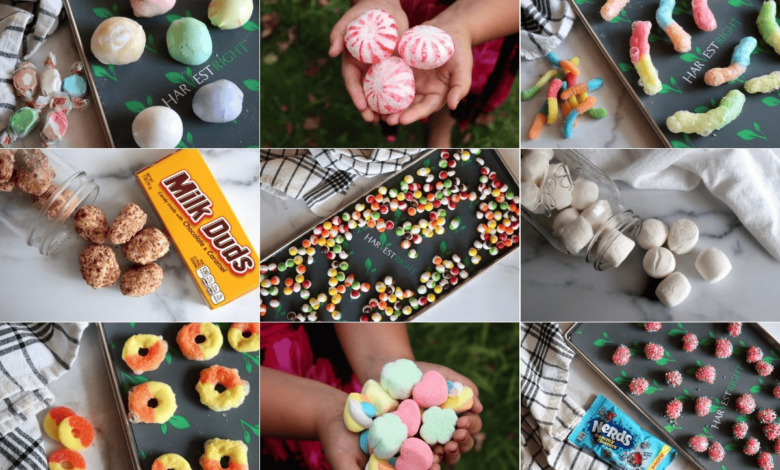How to Make Freeze Dried Candy: A Comprehensive Guide for Sweet Treats

Introduction
Freeze-dried candy has captured the attention of candy lovers and food enthusiasts alike, offering a unique and enjoyable twist on traditional treats. The process of freeze-drying removes moisture from food while preserving its flavor, color, and nutritional value. This results in light, crunchy candies that burst with flavor and provide a delightful eating experience. Whether you’re looking to make a special treat for yourself or impress friends and family with homemade confections, mastering the art of freeze-dried candy is a rewarding endeavor.
Not only does freeze-drying enhance the taste and texture of candies, but it also extends their shelf life significantly. This makes it a perfect option for long-term storage, camping snacks, or simply having fun with flavors in your kitchen. As the trend of DIY candy-making grows, learning how to create freeze-dried candy can elevate your culinary skills and allow you to explore a variety of flavor combinations and ingredient pairings.
In this comprehensive guide, we will delve into the science behind freeze-drying, how to choose the right ingredients, step-by-step instructions for making your own freeze-dried candy, troubleshooting tips, and much more. By the end of this article, you’ll be equipped with all the knowledge needed to create delicious freeze-dried candies at home.
1. Understanding Freeze-Drying
1.1 What is Freeze-Drying?
Freeze-drying, also known as lyophilization, is a preservation method that involves removing moisture from food. The process begins by freezing the food, which helps to maintain its structure and flavor. Once frozen, the food is placed in a vacuum chamber where the pressure is lowered, causing the ice to sublimate. Sublimation is the process where ice turns directly into vapor without becoming liquid. This unique aspect of freeze-drying ensures that the food retains its original taste, nutrients, and vibrant colors.
Unlike traditional drying methods, which can alter the texture and flavor of food, freeze-drying maintains the integrity of the original product. This makes it especially popular for fruits, vegetables, and even candies. The result is a lightweight product that is easy to store and transport, making it ideal for camping trips, emergency supplies, or simply as a fun snack to enjoy at home. Additionally, freeze-dried candy has a satisfying crunch that adds a new dimension to familiar flavors, transforming how we experience our favorite treats.
1.2 The Science Behind Freeze-Drying
The science behind freeze-drying is both fascinating and essential for producing high-quality results. The process consists of three main stages: freezing, primary drying, and secondary drying. First, the food is frozen to a temperature typically below -40°F. This rapid freezing prevents the formation of large ice crystals, which can damage the cell structure of the food. Maintaining the food’s cellular integrity is crucial for retaining its original flavor and texture.
Next, during the primary drying phase, the vacuum chamber reduces the pressure, allowing the ice to sublimate. This phase is the most time-consuming and can take several hours to a few days, depending on the food type and the amount of moisture present. The final stage, secondary drying, involves removing any residual moisture, ensuring the product is shelf-stable. The result is a lightweight, crunchy candy that can be stored for long periods without refrigeration.
Understanding the science behind freeze-drying helps candy makers achieve optimal results and avoid common pitfalls. By following proper techniques and adjusting the process based on the ingredients used, you can create delicious, homemade freeze-dried candy that retains its delightful flavors and textures.
1.3 Equipment Needed for Freeze-Drying
To embark on your freeze-drying journey, you’ll need some essential equipment. The most critical item is, of course, a freeze dryer. There are various types of freeze dryers available on the market, ranging from home models to commercial-grade machines. Home freeze dryers are designed for personal use and can handle small batches of food. They typically feature user-friendly interfaces, allowing you to set the time and temperature easily.
In addition to a freeze dryer, other essential tools include a vacuum sealer and food storage containers. A vacuum sealer helps remove air from packaging, preventing oxidation and extending the shelf life of your freeze-dried candy. Opt for airtight containers or mylar bags for optimal storage, ensuring that your treats remain fresh and flavorful. You may also want a food dehydrator for additional drying options or to prepare certain fruits before freeze-drying.
Lastly, investing in quality ingredients is crucial for achieving the best flavor and texture in your freeze-dried candy. By equipping yourself with the right tools and ingredients, you’ll be well on your way to creating delightful homemade treats.
2. Choosing Ingredients for Freeze-Dried Candy
2.1 Types of Candy Suitable for Freeze-Drying
When it comes to freeze-drying candy, not all types are created equal. Some candies freeze-dry exceptionally well, while others may not yield the desired texture or flavor. Gummy candies, for example, are a popular choice for freeze-drying. Their chewy texture transforms into a light, crunchy treat, and they retain their vibrant colors and fruity flavors. Marshmallows also freeze-dry beautifully, becoming airy and crispy without losing their sweetness.
Fruits are another excellent option for freeze-drying. Strawberries, bananas, and apples are favorites that maintain their natural flavors and colors, offering a healthy and delicious snack. Chocolate-covered candies can be tricky; while they may freeze-dry successfully, the chocolate coating can sometimes become brittle and lose its appeal. For the best results, consider using chocolate or candy coatings specifically designed for freeze-drying.
Experimenting with different types of candies can lead to delightful surprises, so don’t hesitate to try various options. However, it’s essential to keep in mind the moisture content and sugar levels of the ingredients, as these factors can significantly affect the freeze-drying process.
2.2 Preparing Ingredients for Freeze-Drying
Preparation is key to ensuring that your freeze-dried candy turns out perfectly. Start by washing and thoroughly drying any fruits you plan to use. For items like strawberries or apples, it’s beneficial to slice them into uniform pieces to promote even freeze-drying. Smaller pieces will dry faster and more uniformly than larger ones, resulting in a more consistent product.
For gummy candies and marshmallows, there’s no need for extensive preparation; simply arrange them in a single layer on the freeze-dryer trays. However, you might consider lightly dusting them with powdered sugar to prevent sticking during the freeze-drying process. If you’re working with chocolate-covered items, ensure that the chocolate is firm before placing them in the freeze dryer to avoid any mess.
Once your ingredients are prepared, it’s time to load them into the freeze dryer. Make sure not to overcrowd the trays, as this can inhibit proper airflow and lead to uneven drying. By taking the time to prepare your ingredients correctly, you can maximize the flavor and texture of your homemade freeze-dried candy.
3. Step-by-Step Guide to Making Freeze-Dried Candy
3.1 Setting Up Your Freeze Dryer
Before you start freeze-drying your candy, it’s crucial to set up your freeze dryer correctly. Begin by ensuring that your machine is clean and in good working condition. Refer to the manufacturer’s instructions for any specific maintenance or setup guidelines. Most freeze dryers come with a cooling unit that needs to be pre-chilled; this process helps the machine reach the appropriate temperature for freeze-drying.
Once the machine is ready, plug it in and allow it to cool down. Many models will display a cooling indicator light, signaling when it’s time to load your ingredients. Make sure the vacuum pump is functioning properly and check the oil levels, as this can impact the efficiency of the drying process. After everything is set up, you’re ready to load your trays with the prepared candy and fruit.
3.2 Freeze-Drying Process
With your freeze dryer set up and trays loaded, it’s time to begin the freeze-drying process. Start the machine and select the appropriate drying cycle based on the type of candy you are processing. Most freeze dryers have preset options for various food types, including fruits, vegetables, and candies. If your machine does not have a specific setting for candy, choose a cycle designed for fruits or similar items.
During the primary drying phase, keep an eye on the progress. Depending on the size and moisture content of your ingredients, the drying time can vary significantly. Generally, gummy candies may take around 8-12 hours, while fruits can take up to 24 hours or more. After the primary drying phase, the machine will automatically switch to the secondary drying phase, which further removes residual moisture and ensures your candy is shelf-stable.
Once the freeze-drying cycle is complete, check the texture of your candies. They should feel dry, lightweight, and crispy. If any pieces feel soft or moist, consider returning them to the freeze dryer for additional drying time.
3.3 Storing and Enjoying Your Freeze-Dried Candy
Proper storage is essential to maintaining the quality of your freeze-dried candy. Once the candies are fully dried, allow them to cool to room temperature before sealing them in airtight containers. Vacuum-sealed bags or mylar bags are ideal for long-term storage, as they prevent exposure to air and moisture, which can degrade the quality of the candy.
Label your containers with the date and type of candy for easy reference. When stored correctly, freeze-dried candy can last for several months or even years without spoiling, making it a fantastic option for long-term snacking or emergency supplies.
Aside from enjoying freeze-dried candy straight from the bag, consider incorporating it into various recipes. Crush freeze-dried fruits to create flavorful toppings for yogurt, ice cream, or smoothies. Use freeze-dried gummy candies to decorate cakes and cupcakes, adding a unique texture and burst of flavor. The versatility of freeze-dried candy allows for endless creativity in the kitchen, making it a fun and delicious project to undertake.
4. Troubleshooting Common Issues
4.1 Identifying Problems with Freeze-Dried Candy
Even experienced candy makers can encounter issues when freeze-drying. One common problem is insufficient drying, which can leave candies with a chewy or sticky texture. This issue is often caused by overloading the freeze dryer or not allowing enough time for the primary and secondary drying phases. To prevent this, always load the trays in a single layer, ensuring proper airflow, and monitor the drying process closely.
Another potential issue is freezer burn, which can occur if candies are not stored properly after drying. If you notice a dull appearance or off-flavors in your candy, it may be a sign of freezer burn. To avoid this problem, use airtight storage methods and keep your freeze-dried treats in a cool, dark place.
4.2 Tips for Perfecting Your Freeze-Dried Candy
Achieving perfect freeze-dried candy may take a few tries, but with practice and experimentation, you can refine your techniques. Start by keeping detailed notes of your processes, including the types of candies used, preparation methods, drying times, and any adjustments made along the way. This information will be invaluable for replicating successful batches in the future.
Experimenting with flavors and ingredient combinations is also key to perfecting your how to make freeze dried candy. Consider adding spices, flavor extracts, or even dipping your freeze-dried fruits in chocolate for a unique twist. Don’t be afraid to try new things; the world of freeze-drying is full of possibilities.
Conclusion
How to make freeze dried candy at home is a fun and rewarding process that allows you to explore your creativity in the kitchen while enjoying the benefits of a delicious, long-lasting treat. By understanding the science behind freeze-drying, selecting the right ingredients, and following the proper techniques, you can create a variety of delightful candies that retain their flavor and texture.
As you embark on your freeze-drying journey, remember to take your time and experiment with different flavors and combinations. With practice, you’ll soon become a pro at creating your favorite freeze-dried candies. Enjoy the crunchy, flavorful results of your hard work and share your creations with friends and family—there’s no better way to celebrate the art of candy-making!



